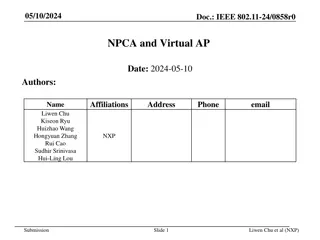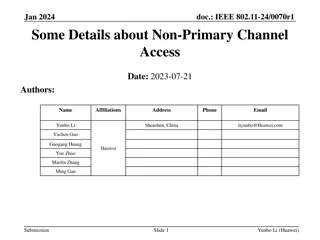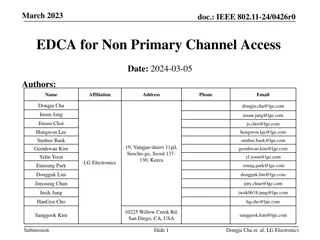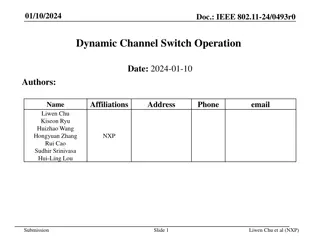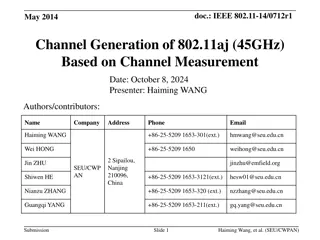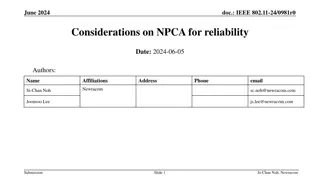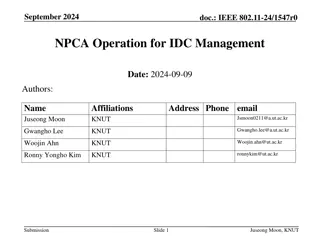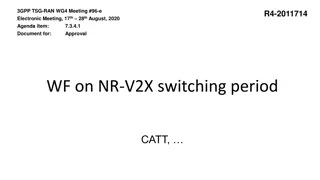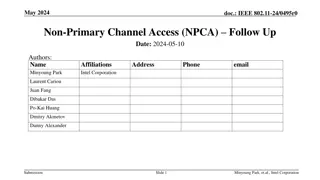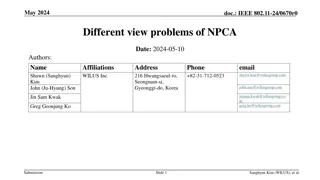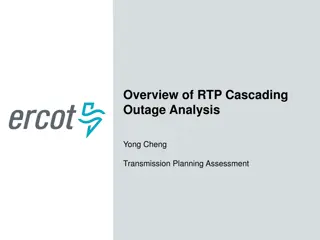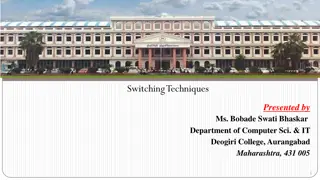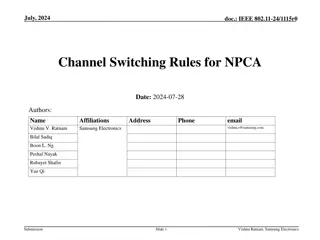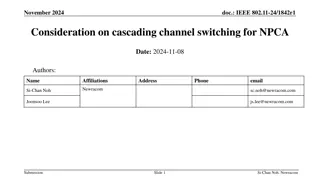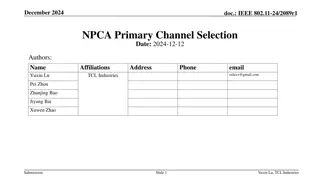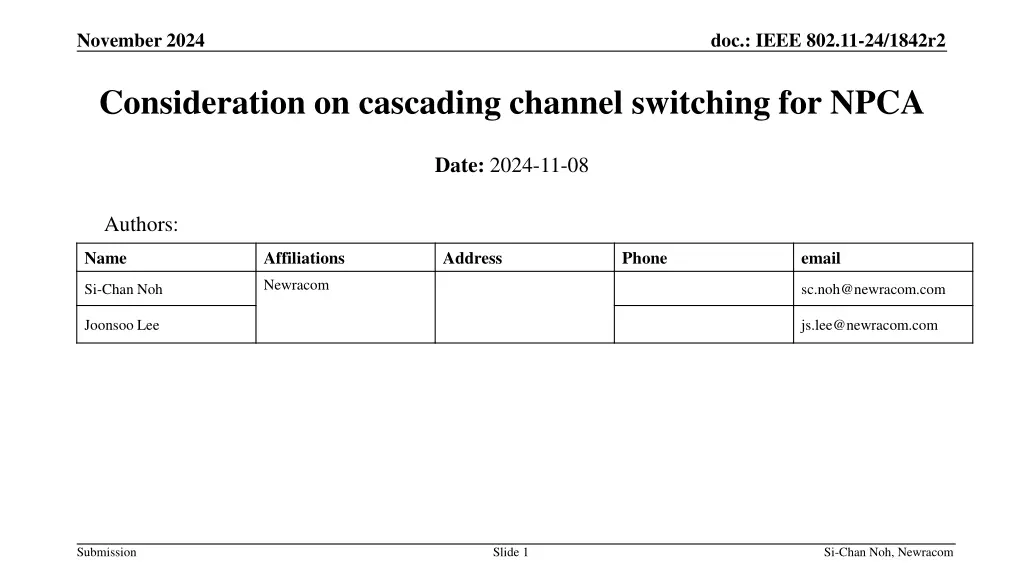
Consideration on Cascading Channel Switching for NPCA in November 2024
This document explores the triggering conditions for channel switching in Non-Primary Channel Access (NPCA) scenarios within the IEEE 802.11-24/1842r2 context. It discusses the implications of NPCA operations on spectral utilization and network performance, particularly when dealing with occupied primary channels and potential cascading channel switching behavior. Authors from Newracom provide valuable insights on optimizing NPCA operations amid OBSS transmissions.
Download Presentation

Please find below an Image/Link to download the presentation.
The content on the website is provided AS IS for your information and personal use only. It may not be sold, licensed, or shared on other websites without obtaining consent from the author. If you encounter any issues during the download, it is possible that the publisher has removed the file from their server.
You are allowed to download the files provided on this website for personal or commercial use, subject to the condition that they are used lawfully. All files are the property of their respective owners.
The content on the website is provided AS IS for your information and personal use only. It may not be sold, licensed, or shared on other websites without obtaining consent from the author.
E N D
Presentation Transcript
November 2024 doc.: IEEE 802.11-24/1842r2 Consideration on cascading channel switching for NPCA Date: 2024-11-08 Authors: Name Affiliations Address Phone email Newracom Si-Chan Noh sc.noh@newracom.com Joonsoo Lee js.lee@newracom.com Submission Slide 1 Si-Chan Noh, Newracom
November 2024 doc.: IEEE 802.11-24/1842r2 Abstract This document discusses the NPCA channel switch triggering conditions for NPCA-supporting STAs from another perspective (i.e., not about the PPDU format, not based on TXOP/PPDU/Service Period(SP), etc) when the primary channel is occupied due to a transmission caused by the NPCA operation of OBSS Submission Slide 2 Si-Chan Noh, Newracom
November 2024 doc.: IEEE 802.11-24/1842r2 Motivation Non-Primary Channel Access (NPCA) channel switch trigger conditions have been discussed in TGbn [1-5] TXOP/PPDU/Service Period based NPCA Control frame exchange/Pre-HE and HE+ format TXOP/PPDU duration constraint to prevent inefficient NPCA If OBSS s transmissions that meet the above conditions occupy the MyBSS primary channel and these transmissions are caused by NPCA operations, should NPCA STAs perform channel switching? It may be needed to consider whether NPCA operation should be performed for all OBSS frames detected on the primary channel Submission Slide 3 Si-Chan Noh, Newracom
November 2024 doc.: IEEE 802.11-24/1842r2 Channel switching for NPCA The NPCA operation may increase spectral utilization of the unused secondary channel when the primary channel is occupied However, it might be necessary to consider the advantages of NPCA when the BSS p-channel is occupied due to a transmission generated by NPCA operations between OBSS s NPCA STAs When NPCA STAs are allowed to switch to the NPCA p-channel regardless of whether the OBSS frame is generated by NPCA operations, frequent channel switching may occur It can reduce power efficiency and degrade overall performance of the BSS Moreover, if a PPDU generated by OBSS NPCA STAs occupy the MyBSS p-channel, it can cause MyBSS NPCA STAs to switch to its NPCA p-channel(Ch1); this may also trigger another OBSS NPCA STAs, which use the aforementioned NPCA p-channel(Ch1) as their BSS p-channel, to switch to their designated NPCA p-channel(Ch2) It can lead to cascading channel switching behavior, which may impact the entire network throughput Submission Slide 4 Si-Chan Noh, Newracom
November 2024 doc.: IEEE 802.11-24/1842r2 Cascading channel switching for NPCA If the NPCA channel switching conditions can be triggered by NPCA operation of an OBSS, we can consider it from two scenarios S1) When OBSS NPCA STAs switch to MyBSS p-channel The number of backoff contenders on the MyBSS p-channel could be increased OBSS NPCA STAs have an advantage, but it can lead to disadvantage to MyBSS STAs If MyBSS STAs cannot access the channel, allowing MyBSS NPCA STAs to perform NPCA might be an efficient way However, there may be situations where waiting until the end of the frame exchange between OBSS s NPCA STAs (i.e., at the time when switching back to their p-channel) on the MyBSS p-channel is more beneficial at some points than performing NPCA This is because we cannot ensure the NPCA p-channel for MyBSS NPCA STAs will be IDLE; In addition, since congestion due to OBSS NPCA STAs can be merely temporary, having MyBSS NPCA STAs switch channels while consuming power could reduce power effieciency S2) When MyBSS NPCA STAs switch channel due to NPCA operation of an OBSS In terms of OBSS that using the MyBSS NPCA primary channel as its BSS p-channel, this could increase the number of backoff contenders and potentially trigger NPCA operation in that OBSS It can bring S1) recursively Submission Slide 5 Si-Chan Noh, Newracom
November 2024 doc.: IEEE 802.11-24/1842r2 Example of cascading channel switching Description : The NPCA available channels of BSS1/BSS2 overlap with the primary channels of BSS2/BSS3, respectively Freq. Scenario : BSS1 NPCA STAs switch channel to its NPCA p-channel BSS1 NPCA STAs contend with BSS2 STAs, and with the channel contention BSS2 NPCA STAs switch channel to its NPCA p-channel BSS2 NPCA STAs contend with BSS3 STAs, and with the channel contention BSS3 NPCA STAs switch channel to its NPCA p-channel BSS3 NPCA STAs contend with BSS_X STAs and with the channel contention BSS3 NPCA BSS2 NPCA available channel ( BSS3 primary channel) BSS3 NPCA STAs switch back BSS3 NPCA STAs switch BSS2 NPCA BSS2 NPCA STAs switch back BSS2 NPCA STAs switch BSS1 NPCA available channel ( BSS2 primary channel) BSS2 BSS3 BSS1 BSS1 NPCA BSS1 NPCA STAs switch back BSS1 NPCA STAs switch AP1 AP2 AP3 OBSS TXOP Submission Slide 6 Si-Chan Noh, Newracom
November 2024 doc.: IEEE 802.11-24/1842r2 Prevent cascading channel switching Since the NPCA p-channel during the NPCA operation can cause cascading channel switching of OBSS NPCA STAs, we consider methods to limit cascading channel switching Proposal 1: Switch to the NPCA p-channel when an NPCA triggering event occurs from an OBSS with the same p-channel as MyBSS It can prevent cascading channel switching in advance Moreover, it can help resolve ambiguity about whether the OBSS s BW overlaps with MyBSS NPCA p-channel However, when there are few OBSSs with the same p-channel with MyBSS, NPCA opportunities may be relatively limited Submission Slide 7 Si-Chan Noh, Newracom
November 2024 doc.: IEEE 802.11-24/1842r2 Prevent cascading channel switching Proposal 2: Including an explicit indication in the PPDU to notify that this PPDU is generated from the NPCA operation If the NPCA STA initiates frame exchange on the NPCA p-channel with an ICF, it may include an indication within the ICF to prevent NPCA operation of OBSS; and/or Indicate the NPCA mark within the UHR SIG field when transmitting UHR PPDU format When NPCA STAs overhear the NPCA indication on their BSS p-channel, they may optionally choose whether to perform NPCA or not as follows : Opt 1) Do not perform NPCA until the OBSS NPCA STAs switch back to their p-channel Opt 2) Switching to NPCA p-channel to perform NPCA; After that, do not use untriggered transmission, considering the trade-off between the benefits of NPCA and the increase in backoff contenders due to NPCA Allow only the NPCA AP to attempt channel contention Submission Slide 8 Si-Chan Noh, Newracom
November 2024 doc.: IEEE 802.11-24/1842r2 Summary In this presentation, we discuss some approaches for NPCA STAs to mitigate the excessive NPCA which can cause cascading channel switching Switch to the NPCA primary channel when an NPCA triggering event occurs from an OBSS with the same primary channel as MyBSS Including an explicit indication in the PPDU ICF when NPCA STAs initiate frame exchange on the NPCA primary channel; and/or Transmission of UHR PPDU format between NPCA STAs on the NPCA available channel Submission Slide 9 Si-Chan Noh, Newracom
November 2024 doc.: IEEE 802.11-24/1842r2 Reference [1] 24/0495r0, Non-Primary Channel Access (NPCA) - Follow up [2] 24/0496r1, Secondary Channel Usage Follow Up [3] 24/1115r1, Channel Switching Rules for NPCA [4] 24/1259r0, SP-based non-primary channel access follow-up [5] 24/1218r1, NPCA Next level discussions Submission Slide 10 Si-Chan Noh, Newracom
November 2024 doc.: IEEE 802.11-24/1842r2 SP1 Do you agree to include an explicit indication in the ICF and/or UHR PPDU on the NPCA primary channel during NPCA operation? The details are TBD Submission Slide 11 Si-Chan Noh, Newracom
November 2024 doc.: IEEE 802.11-24/1842r2 SP2 Do you agree to allow NPCA operation when the event triggering the switch to the NPCA primary channel is from an OBSS with the same primary channel as MyBSS primary channel? Submission Slide 12 Si-Chan Noh, Newracom
November 2024 doc.: IEEE 802.11-24/1842r2 SP3 Do you agree to define a mode of operation in NPCA where the BSS primary channel is occupied due to frame exchange between OBSS s NPCA STAs based on NPCA operation? This mode can be enabled/disabled by the AP Submission Slide 13 Si-Chan Noh, Newracom



